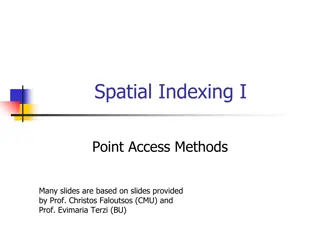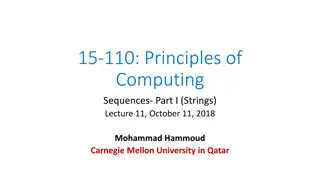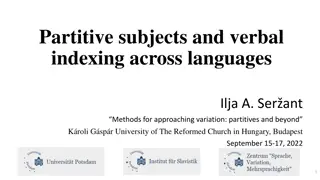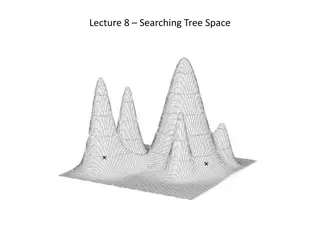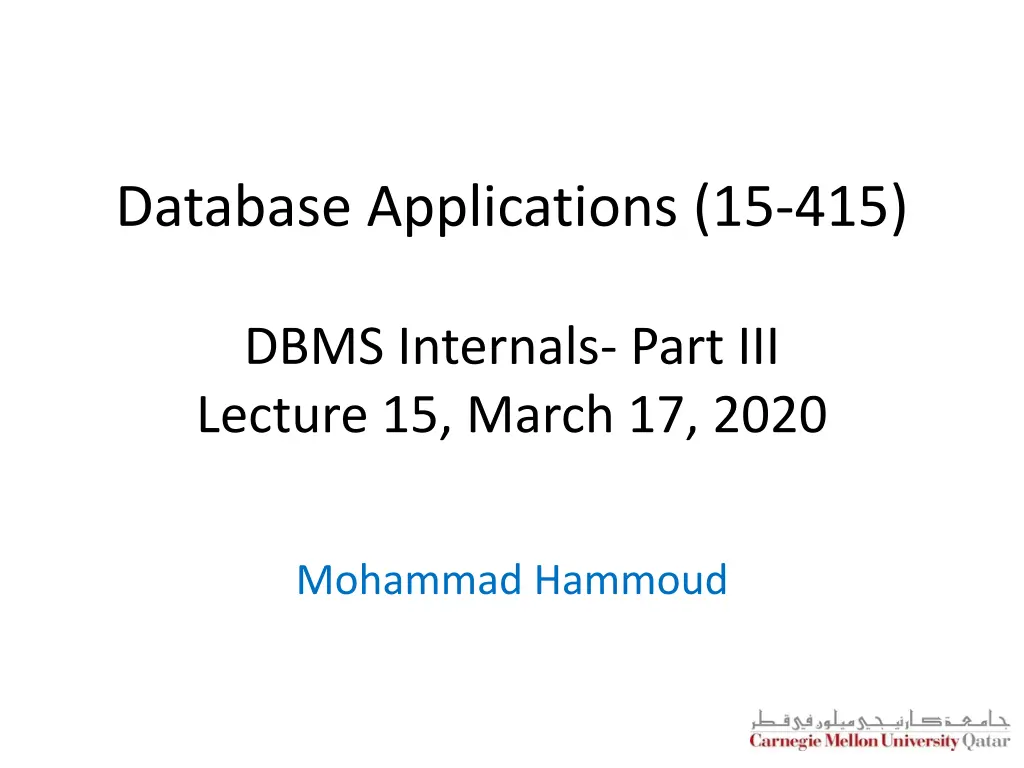
DBMS Internals: Tree-based Indexing Methods
Explore the intricacies of tree-based indexing methods in Database Management Systems, focusing on ISAM and B+ trees. Understand the importance of indexing for efficient data retrieval and learn how these methods optimize query performance. Dive into the motivation behind creating index files and storing data records to enhance database operations.
Download Presentation

Please find below an Image/Link to download the presentation.
The content on the website is provided AS IS for your information and personal use only. It may not be sold, licensed, or shared on other websites without obtaining consent from the author. If you encounter any issues during the download, it is possible that the publisher has removed the file from their server.
You are allowed to download the files provided on this website for personal or commercial use, subject to the condition that they are used lawfully. All files are the property of their respective owners.
The content on the website is provided AS IS for your information and personal use only. It may not be sold, licensed, or shared on other websites without obtaining consent from the author.
E N D
Presentation Transcript
Database Applications (15-415) DBMS Internals- Part III Lecture 15, March 17, 2020 Mohammad Hammoud
Today Last Session: DBMS Internals- Part II Buffer Management Files and Access Methods (file organizations) Today s Session: DBMS Internals- Part III Tree-based indexes: ISAM and B+ trees Announcement: Project 2 is due on March 25 by midnight
DBMS Layers Queries Query Optimization and Execution Relational Operators Files and Access Methods Transaction Manager Recovery Manager Buffer Management Lock Manager Disk Space Management DB
Outline Why Indexing? Storing Data Records and Index Types Indexed Static Access Method (ISAM) Trees B+ Trees
Motivation Consider a file of student records sorted by GPA Page N Page 3 Page 1 Data File Page 2 How can we answer a range selection (E.g., Find all students with a GPA higher than 3.0 )? What about doing a binary search followed by a scan? Yes, but What if the file becomes very large? Cost is proportional to the number of pages fetched Hence, may become very slow!
Motivation What about creating an index file (with one entry per page) and do binary search there? Index Entry = <first key on the page, pointer to the page> Index File K1 PN P1 K 2 P2 KN Page N Page 1 Data File Page 2 But, what if the index file becomes also very large?
Motivation Repeat recursively! Non-leaf Pages Leaf Pages Each tree page is a disk block and all data records reside (if chosen to be part of the index) in ONLY leaf pages How else data records can be stored?
Outline Why Indexing? Storing Data Records and Index Types Indexed Static Access Method (ISAM) Trees B+ Trees
Where to Store Data Records? In general, 3 alternatives for data records (each referred to as K*) can be pursued: Alternative (1): K* is an actual data record with key k Alternative (2): K* is a <k, rid> pair, where rid is the record id of a data record with search keyk Alternative (3): K* is a <k, rid-list> pair, where rid-list is a list of rids of data records with search key k
Where to Store Data Records? In general, 3 alternatives for data records (each referred to as K*) can be pursued: Alternative (1): K* is an actual data record with key k Alternative (1): Leaf pages contain the actual data (i.e., the data records) Alternative (2): K* is a <k, rid> pair, where rid is the record id of a data record with search keyk records are stored in a separate file Alternative (2): Leaf pages contain the <key, rid> pairs and actual data Alternative (3): K* is a <k, rid-list> pair, where rid-list is a list of rids of data records with search key k records are stored in a separate file Alternative (3): Leaf pages contain the <key, rid-list> pairs and actual data The choice among these alternatives is orthogonal to the indexing technique
Clustered vs. Un-clustered Indexes Indexes can be either clustered or un-clustered Clustered Indexes: When the ordering of data records is the same as (or close to) the ordering of entries in some index Un-clustered Indexes: When the ordering of data records differs from the ordering of entries in some index
Clustered vs. Un-clustered Indexes Is an index that uses Alternative (1) clustered or un-clustered? Clustered Is an index that uses Alternative (2) or (3) clustered or un-clustered? Clustered only if data records are sorted on the search key field In practice: A clustered index is an index that uses Alternative (1) Indexes that use Alternatives (2) or (3) are un-clustered
Outline Why Indexing? Storing Data Records and Index Types Indexed Static Access Method (ISAM) Trees B+ Trees
ISAM Trees Indexed Sequential Access Method (ISAM) trees are static Root 40 Non-Leaf Pages 51 63 20 33 Leaf Pages 46* 55* 40* 51* 97* 10* 15* 20* 27* 33* 37* 63* E.g., 2 Entries Per Page
ISAM Trees: Page Overflows What if there are a lot of insertions after creating the tree? Non-leaf Pages Leaf Pages Overflow page Primary pages
ISAM File Creation How to create an ISAM file? All leaf pages are allocated sequentially and sorted on the search key value If Alternative (2) or (3) is used, the data records are created and sorted before allocating leaf pages The non-leaf pages are subsequently allocated
ISAM: Searching for Entries Search begins at root, and key comparisons direct it to a leaf Search for 27* Root 40 20 33 51 63 46* 55* 10* 15* 20* 27* 33* 37* 40* 51* 97* 63*
ISAM: Inserting Entries The appropriate page is determined as for a search, and the entry is inserted (with overflow pages added if necessary) Insert 23* Root 40 20 33 51 63 46* 55* 10* 15* 20* 27* 33* 37* 40* 51* 97* 63* 23*
ISAM: Inserting Entries The appropriate page is determined as for a search, and the entry is inserted (with overflow pages added if necessary) Insert 48* Root 40 20 33 51 63 46* 55* 10* 15* 20* 27* 33* 37* 40* 51* 97* 63* 23* 48*
ISAM: Inserting Entries The appropriate page is determined as for a search, and the entry is inserted (with overflow pages added if necessary) Insert 41* Root 40 20 33 51 63 46* 55* 10* 15* 20* 27* 33* 37* 40* 51* 97* 63* 41* 23* 48*
ISAM: Inserting Entries The appropriate page is determined as for a search, and the entry is inserted (with overflow pages added if necessary) Insert 42* Root 40 20 33 51 63 46* 55* 10* 15* 20* 27* 33* 37* 40* 51* 97* 63* 41* 23* 48* Chains of overflow pages can easily develop! 42*
ISAM: Deleting Entries The appropriate page is determined as for a search, and the entry is deleted (with ONLY overflow pages removed when becoming empty) Root Delete 42* 40 20 33 51 63 46* 55* 10* 15* 20* 27* 33* 37* 40* 51* 97* 63* 41* 23* 48* 42*
ISAM: Deleting Entries The appropriate page is determined as for a search, and the entry is deleted (with ONLY overflow pages removed when becoming empty) Root Delete 42* 40 20 33 51 63 46* 55* 10* 15* 20* 27* 33* 37* 40* 51* 97* 63* 41* 23* 48*
ISAM: Deleting Entries The appropriate page is determined as for a search, and the entry is deleted (with ONLY overflow pages removed when becoming empty) Root Delete 42* 40 20 33 51 63 46* 55* 10* 15* 20* 27* 33* 37* 40* 51* 97* 63* 41* 23* 48*
ISAM: Deleting Entries The appropriate page is determined as for a search, and the entry is deleted (with ONLY overflow pages removed when becoming empty) Root Delete 51* 40 20 33 51 63 46* 55* 10* 15* 20* 27* 33* 37* 40* 51* 97* 63* 41* 23* 48* Note that 51 still appears in an index entry, but not in the leaf!
ISAM: Deleting Entries The appropriate page is determined as for a search, and the entry is deleted (with ONLY overflow pages removed when becoming empty) Root Delete 55* 40 20 33 51 63 46* 55* 10* 15* 20* 27* 33* 37* 40* 97* 63* 41* 23* 48* Primary pages are NOT removed, even if they become empty!
ISAM: Some Issues Once an ISAM file is created, insertions and deletions affect only the contents of leaf pages (i.e., ISAM is a static structure!) Since index-level pages are never modified, there is no need to lock them during insertions/deletions Critical for concurrency! Long overflow chains can develop easily The tree can be initially set so that ~20% of each page is free If the data distribution and size are relatively static, ISAM might be a good choice to pursue!
Outline Why Indexing? Storing Data Records in Indexes and Index Types Indexed Static Access Method (ISAM) Trees B+ Trees
Dynamic Trees ISAM indices are static Long overflow chains can develop as the file grows, leading to poor performance This calls for more flexible, dynamic indices that adjust gracefully to insertions and deletions No need to allocate the leaf pages sequentially as in ISAM Among the most successful dynamic index schemes is the B+ tree
B+ Tree Properties Each node in a B+ tree of order d(this is a measure of the capacity of a tree): Has at most 2dkeys Has at least dkeys (except the root, which may have just 1 key) All leaves are on the same level Has exactly n-1 keys if the number of pointers is n p1 Points to a sub-tree in which all keys are less than k1 pn+1 Points to a sub-tree in which all keys are greater than or equal kn kn k1 k2 Points to a sub-tree in which all keys are greater than or equal k1 and less than to k2
B+ Tree: Searching for Entries Search begins at root, and key comparisons direct it to a leaf (as in ISAM) Example 1: Search for entry 5* Root 30 24 13 17 33* 34* 38* 39* 19* 20* 22* 24* 27* 29* 3* 5* 2* 7* 14* 16*
B+ Tree: Searching for Entries Search begins at root, and key comparisons direct it to a leaf (as in ISAM) Example 2: Search for entry 15* Root 30 24 13 17 33* 34* 38* 39* 19* 20* 22* 24* 27* 29* 3* 5* 2* 7* 14* 16* 15* is not found!
B+ Trees: Inserting Entries Find correct leaf L Put data entry onto L If Lhas enough space, done! Else, splitL into L and a new node L2 Re-partition entries evenly, copying up the middle key Parent node may overflow Push upmiddle key (splits grow trees; a root split increases the height of the tree)
B+ Tree: Examples of Insertions Insert entry 8* Root 30 24 13 17 33* 34* 38* 39* 19* 20* 22* 24* 27* 29* 3* 5* 2* 7* 14* 16* Leaf is full; hence, split!
B+ Tree: Examples of Insertions Insert entry 8* Root 30 24 13 17 33* 34* 38* 39* 19* 20* 22* 24* 27* 29* 3* 5* 2* 7* 14* 16* The middle key(i.e., 5)is copied up and continues to appear in the leaf 5 3* 5* 2* 7* 8*
B+ Tree: Examples of Insertions Insert entry 8* Root 30 24 13 17 33* 34* 38* 39* 19* 20* 22* 24* 27* 29* 3* 5* 2* 7* 14* 16* 5 30 24 13 17 5 >2d keys and 2d + 1 pointers 3* 5* 2* 7* 8* Parent is full; hence, split!
B+ Tree: Examples of Insertions Insert entry 8* Root 30 24 13 17 33* 34* 38* 39* 19* 20* 22* 24* 27* 29* 3* 5* 2* 7* 14* 16* The middle key (i.e., 17) is pushed up 17 5 3* 5* 5 13 24 30 2* 7* 8*
B+ Tree: Examples of Insertions 17 Insert entry 8* 5 13 24 30 Root 30 24 13 17 33* 34* 38* 39* 19* 20* 22* 24* 27* 29* 3* 5* 2* 7* 14* 16* 3* 5* 2* 7* 8*
B+ Tree: Examples of Insertions Insert entry 8* Root FINAL TREE! 17 24 5 13 30 33* 34* 38* 39* 2* 3* 5* 7* 8* 19* 20* 22* 24* 27* 29* 14* 16* Splitting the root lead to an increase of height by 1! What about re-distributing entries instead of splitting nodes?
B+ Tree: Examples of Insertions Insert entry 8* Root 30 24 13 17 33* 34* 38* 39* 19* 20* 22* 24* 27* 29* 3* 5* 2* 7* 14* 16* Poor Sibling Leaf is full; hence, check the sibling
B+ Tree: Examples of Insertions Insert entry 8* Root 30 24 13 17 Do it through the parent 33* 34* 38* 39* 19* 20* 22* 24* 27* 29* 3* 5* 2* 7* 14* 16*
B+ Tree: Examples of Insertions Insert entry 8* Root 30 24 13 8 17 Do it through the parent 33* 34* 38* 39* 19* 20* 22* 24* 27* 29* 3* 5* 2* 7* 14* 16* 8* Copy up the new low key value! But, when to redistribute and when to split?
Splitting vs. Redistributing Leaf Nodes Previous and next-neighbor pointers must be updated upon insertions (if splitting is to be pursued) Hence, checking whether redistribution is possible does not increase I/O Therefore, if a sibling can spare an entry, re-distribute Non-Leaf Nodes Checking whether redistribution is possible usually increases I/O Splitting non-leaf nodes typically pays off!
B+ Insertions: Keep in Mind Every data entry must appear in a leaf node; hence, copy up the middle key upon splitting When splitting index entries, simply push up the middle key Apply splitting and/or redistribution on leaf nodes Apply only splitting on non-leaf nodes
B+ Trees: Deleting Entries Start at root, find leaf L where entry belongs Remove the entry If L is at least half-full, done! If Lunderflows Try to re-distribute (i.e., borrow from a rich sibling and copy up its lowest key) If re-distribution fails, mergeLand a poor sibling Update parent And possibly merge, recursively
B+ Tree: Examples of Deletions Delete 19* Root 17 24 30 5 13 33* 34* 38* 39* 2* 3* 19* 20* 22* 24* 27* 29* 5* 7* 8* 14* 16* Removing 19* does not cause an underflow
B+ Tree: Examples of Deletions Delete 19* Root 17 24 30 5 13 33* 34* 38* 39* 2* 3* 24* 27* 29* 5* 7* 8* 20* 22* 14* 16* FINAL TREE!
B+ Tree: Examples of Deletions Delete 20* Root 17 24 30 5 13 33* 34* 38* 39* 2* 3* 24* 27* 29* 5* 7* 8* 20* 22* 14* 16* Deleting 20* causes an underflow; hence, check a sibling for redistribution
B+ Tree: Examples of Deletions Delete 20* Root 17 24 30 5 13 33* 34* 38* 39* 2* 3* 24* 27* 29* 5* 7* 8* 20* 22* 14* 16* The sibling is rich (i.e., can lend an entry); hence, remove 20* and redistribute!
B+ Tree: Examples of Deletions Delete 20* Is it done? Root 17 24 30 5 13 33* 34* 38* 39* 2* 3* 27* 29* 5* 7* 8* 14* 16* 24* 22* Copy up 27*, the lowest value in the leaf from which we borrowed 24*












